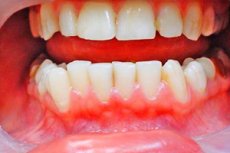Medical expert of the article
New publications
Ulcerative-necrotic gingivitis of Vensen
Last reviewed: 29.06.2025

All iLive content is medically reviewed or fact checked to ensure as much factual accuracy as possible.
We have strict sourcing guidelines and only link to reputable media sites, academic research institutions and, whenever possible, medically peer reviewed studies. Note that the numbers in parentheses ([1], [2], etc.) are clickable links to these studies.
If you feel that any of our content is inaccurate, out-of-date, or otherwise questionable, please select it and press Ctrl + Enter.

Dentists consider venous necrotizing ulcerative gingivitis of Vencesan as a specific form of inflammatory gum disease, which may also be called venous necrotizing ulcerative gingivostomatitis of Vencesan, fusospirochete (fusospirillosis) gingivitis or necrotizing acute ulcerative gingivitis. The ICD-10 code for this disease is A69.1. [1]
Epidemiology
Acute necrotizing ulcerative gingivitis is a fairly rare infectious disease of the gum tissue, affecting less than 1% of the population (most commonly adolescents and young adults).
Ulcerative-necrotizing gingivitis also occurs in young children, especially when immunosuppressed or severely debilitated.
Causes of the ulcerative necrotizing gingivitis.
Gingival inflammation in ulcerative-necrotizing Wensan gingivitis is caused by an opportunistic infection - invasion of the epithelium and underlying soft tissues of the gingiva by a symbiosis of such obligate microorganisms (microbiota) of the oral cavity as fusobacteria fusobacterium nucleatum (Plauta bacilli or Plauta-Vensana bacilli) and Fusobacterium necroforum, gram-negative bacillus-anaerobes Prevotella intermedia and Bacillus fusiformis, spirochetes (spiral bacteria) Treponema vincentii (Borrelia vincentii) and Treponema denticola. All of them, present in the gingival sulcus and plaque, are considered to be commensal pathogens.
The peculiarity of the severe form of ulcerative gingivitis provoked by these bacteria is the development of a purulent inflammatory process with focal or diffuse ulceration of the gingival tissue - with ulcers on the gums of the child and adult - and necrosis of the tissue between the teeth, that is, the interdental gingival papillae. [2]
Risk factors
Risk factors for developing this disease include:
- Weakened immunity (including HIV, radiation sickness, malignant neoplasms and leukemia);
- Poor oral hygiene and plaque buildup;
- Alimentary dystrophy and anorexia (i.e., nutritional deficiencies);
- Smoking;
- Pre-existing gingivitis;
- Psychological stress.
Pathogenesis
In inflammation of bacterial origin, the pathogenesis is related to the virulence of microorganisms and their invasiveness. In case of ulcerative gingivitis with necrosis, anaerobic pleomorphic gram-negative bacillus Fusobacterium nucleatum damages cell membranes of the gingival mucosal epithelium, cleaving their phospholipids with its enzymes. This bacterium also binds and activates the blood proenzyme plasminogen, which leads to the formation of the fibrinolytic enzyme plasmin, which causes increased bleeding of the gums.
And spirochetes of the oral microbiota Treponema vincentii and Treponema denticola with the help of their protease enzymes attach to the proteins of the cells of the gingival connective tissue, bind to their membranes and penetrate into the cells, causing destruction of the cells themselves and damage to the extracellular matrix by products of their metabolism, which have a cytotoxic effect. [3]
Symptoms of the ulcerative necrotizing gingivitis.
The earliest signs of ulcerative-necrotic gingivitis Vensant are manifested by marked redness of the gums.
Also, the main symptoms of the disease in the first stage include swelling of the soft tissues of the gums, which bleed easily. Small, painful ulcers appear on the gums (on the edges adjacent to the teeth); there is intense pain in the gum and soreness when swallowing and talking.
Due to the necrosis of gum tissue in the interdental spaces, there is a stinky breath odor, there may be an unpleasant (metallic) taste. There may also be general malaise, subfebrile body temperature and fever.
Do not exclude the spread of ulcers on the palatine tonsils and throat mucosa, and in advanced cases, inflammation leads to an increase in submandibular lymph nodes.
If acute fusospirochetal gingivitis is left untreated or treated incorrectly, the inflammation recurs from time to time, that is, chronic necrotizing ulcerative gingivitis develops with very severe consequences. [4]
Complications and consequences
Aggravating complications and consequences of ulcerative necrotizing gingivitis such as:
- Necrotizing stomatitis;
- Necrotizing periodontitis;
- Development of severe gangrenous infection of the soft and bony tissues of the orofacial region - Wensan's disease or noma (which can be fatal).
In children with cancer, poor nutrition, neutropenia, and inadequate oral hygiene, ulcerative necrotizing gingivitis can lead to tooth loss.
Diagnostics of the ulcerative necrotizing gingivitis.
The diagnosis of this gum disease is made on the basis of initial clinical symptoms - based on the results of oral examination.
To confirm it, bacterioscopy and microbiological analysis of smears from necrotic masses (for fusospirochete bacteria) are performed; if necessary, blood tests are taken.
Differential diagnosis
Differential diagnostics with streptococcal and gonococcal gingivitis, herpetic gingivostomatitis, aphthous stomatitis (including Behcet's disease), recurrent necrotizing periadenitis, infectious mononucleosis, erythema multiforme and vulgar vesicular. [5]
Treatment of the ulcerative necrotizing gingivitis.
Treatment of necrotizing acute ulcerative gingivitis depends on the stage of the pathological process and includes:
- Rinsing ulcerative lesions by mouthwash with 0.05-0.12% chlorhexidine or 1-1.5% hydrogen peroxide solution (several times during the day);
- Superficial ultrasound oral hygiene and tartar removal
- Removal of dead gum tissue - necrectomy.
Systemic antibiotics active against fusospirochete infection are prescribed, and the drug of choice today is Metronidazole (from the group of imidazole derivatives), which is taken three times a day for 250 mg for a week. Antihistamines (Loratadine or Cetrin) are used to reduce swelling of the gums. [6], [7]
Read more in the articles:
Prevention
To prevent fusospirochete gingivitis, dentists advise eating a nutritious diet, maintaining your immune system, and brushing your teeth regularly to remove plaque.
Forecast
Mechanical removal of necrotic tissues and adequate drug treatment of ulcerative-necrotic gingivitis Vencesan usually prevent progression; pathological process, and then gingival ulcers can heal without negative consequences with a favorable prognosis of the outcome of the disease.

